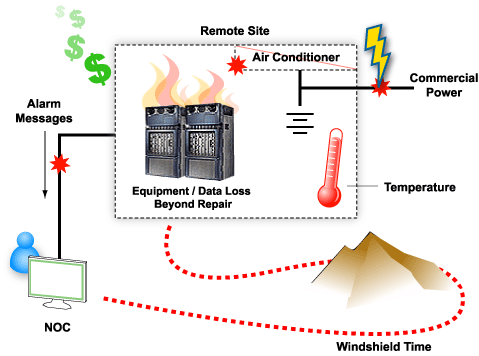Download our free Monitoring Fundamentals Tutorial.
An introduction to Monitoring Fundamentals strictly from the perspective of telecom network alarm management.
1-800-693-0351
Have a specific question? Ask our team of expert engineers and get a specific answer!
Sign up for the next DPS Factory Training!

Whether you're new to our equipment or you've used it for years, DPS factory training is the best way to get more from your monitoring.
Reserve Your Seat TodayOften, temperature monitoring is overlooked. But it is one of the key environmental alarms to monitor in every unmanned remote site. From both spectrums of the temperature range, it is very important to monitor what conditions your revenue-generating equipment are operating under.
If your air conditioning unit failed and you didn't have adequate monitoring of the unit or temperature at your site, you would be unaware of the damage and would be too late in preventing equipment thermal shutdown and failure.

There are two ways that you can monitor temperature, the most basic is a discrete threshold alarm. This is very similar to a thermostat where you would set a high-point threshold and a low-point threshold. When these presets were exceeded you would get a contact closure alarm, which would translate to a basic high or low temperature alarm. The down side to this type of alarm is that if your threshold was set to 80°F, you could be at 81°F or 181°F and all you would know is that your high temperature alarm was tripped. Having greater detail would affect how you would dispatch your technicians to the site.
Another type of temperature monitoring uses analog values. Analog monitoring allows you to monitor the live data at your remote sites. In this instance you would be able to see the current temperature at your remote site. You can use your analog values to send alarms based off of user configurable thresholds, allowing you to have different thresholds for low critical, low, high, and high critical temperature alarms. You would also be able to inspect the live temperature values in detail at the remote site.
Most analog temperature sensors need +12V power. In a teleco environment equipment is typically powered with -48V. You could run your temperature sensor off of commercial power, but during power outages you will lose your temperature sensor. A common best practice is to use an RTU like the NetGuardian 832A that will provide power your temperature sensor from a -48V power source. This ensures your temperature monitoring is online when you need it.
Another advantage of analog value alarm monitoring is the ability to monitor the escalation of the analog values. This would give you insight as to how fast the temperature is rising or dropping, allowing you to better dispatch personnel.
It's vitally important to monitor the temperature levels at your remote sites. To get the most detailed visibility of site temperature, you need a remote that monitors four separate analog thresholds, like the NetGuardian 832A.
With four thresholds you can set separate major and minor alarms for both high and low temperatures. This gives you both an advanced warning if temperatures are starting to leave the optimum range (e.g., the air conditioner is not working right and the temperature has risen to 80°F) and a final notification when temperatures have reached the danger point (e.g., the air conditioner is not working at all, and the temperature is 100°F).
Knowing both inside and outside temperatures gives you the overall picture. Imagine if the outside temperature is 150°F and your AC stopped working, with this knowledge you know you better dispatch a technician fast as the temperature is sure to rise quickly.
Excessive heat cooks electronic equipment, even carrier-grade telecom gear. It's essential to constantly monitor temperature at your remote sites with four-threshold and live value analog alarms. Heat also damages other equipment. High temperatures will dramatically shorten the useful life of your batteries. A lead-acid battery that would last 10 years under ordinary conditions will last only a year if it's consistently operated at temperatures over 122 degrees Fahrenheit.
In a recent case a telecommunications company lost a remote site with hundreds of thousands of dollars of equipment due to the lack of temperature monitoring. With the added heat radiation of servers and equipment, the site quickly turned into an oven cooking the equipment beyond repair.
It's important to monitor the HVAC systems that maintain your remote site environment. If you can catch an air conditioning failure early, you can intervene, start repairs and restore the remote site environment before equipment goes into thermal shutdown or the site goes dark.
Don't forget to also provide a secondary power supply for HVAC systems. An often-overlooked danger of power outages is that the telecom equipment will continue to run on backup power while the air conditioning, connected only to commercial power, is out.
The equipment keeps running, the heat keeps raising, until the temperature forces a thermal shutdown.
Learn More About Remote Temperature Sensors and Environmental Monitoring